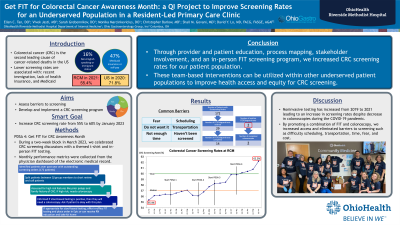Sunday Poster Session
Category: Colorectal Cancer Prevention
P0335 - Get FIT Campaign for Colorectal Cancer Awareness Month: A QI Project to Improve Screening Rates for an Underserved Population in a Resident-Led Primary Care Clinic
Sunday, October 22, 2023
3:30 PM - 7:00 PM PT
Location: Exhibit Hall

Has Audio

Ellen C. Tan, DO
OhioHealth Riverside Methodist Hospital
Columbus, OH
Presenting Author(s)
Ellen C. Tan, DO1, Vivek V. Jasti, MD1, Sarah Grebennikov, DO1, Monika Marcinkevicius, DO1, Christopher Barlow, MD1, Shail M. Govani, MD2, David Y. Lo, MD, FACG2
1OhioHealth Riverside Methodist Hospital, Columbus, OH; 2Ohio Gastroenterology Group, Inc., Columbus, OH
Introduction: Colorectal cancer (CRC) is the second leading cause of cancer-related deaths in the USA and can be prevented through adequate screening. Many factors influence screening completion, such as provider recommendation, method of screening, transportation, health insurance status, race/ethnicity, and socioeconomic status. Lower screening rates are associated with recent immigration, lack of health insurance, and Medicaid insurance. Our clinic is made up of 14% non-English speaking or immigrant status patients, and 48% have Medicaid insurance or are uninsured. In 2020, our CRC screening rate was 55.4% compared to the national average of 71.8%. Our aim was to assess barriers to screening to develop and implement a CRC screening program.
Methods: The quality improvement (QI) initiative started with a patient questionnaire assessing barriers to CRC screening completion. Four Plan-Do-Study-Act (PDSA) cycles were implemented: resident education on guidelines and screening modalities, patient education using visual aids, decision support tool with price transparency and financially assisted colonoscopies for uninsured patients, provider alerts, and our “Get FIT” campaign for CRC awareness month. During a two-week block in March 2023, we celebrated CRC screening discussions with a themed shirt and in-person FIT testing. We called average-risk patients with outstanding screening orders for FIT testing. Monthly performance metrics were collected from the physician dashboard of the electronic medical record.
Results: Common barriers were scheduling difficulties, transportation, time, fear, cost, lack of desire, and no CRC screening discussion. Over 18 months, CRC screening rates increased from 55.4% to 60.4%. 172 patients were called during the “Get FIT” campaign and 50% of tests ordered were completed within one month. We increased the number and completion rate of stool-based tests ordered.
Discussion: Through provider and patient education, process mapping, stakeholder involvement, and an in-person FIT screening program, we increased CRC screening rates for our patient population. Noninvasive testing has increased from 2019 to 2021 leading to an increase in screening rates despite decrease in colonoscopies during the COVID-19 pandemic. Our PDSA cycles offered a combination of FIT and colonoscopy, increasing participation and removing barriers to screening. These team-based interventions can be utilized within other underserved patient populations to improve health access and equity for CRC screening.
Disclosures:
Ellen C. Tan, DO1, Vivek V. Jasti, MD1, Sarah Grebennikov, DO1, Monika Marcinkevicius, DO1, Christopher Barlow, MD1, Shail M. Govani, MD2, David Y. Lo, MD, FACG2. P0335 - Get FIT Campaign for Colorectal Cancer Awareness Month: A QI Project to Improve Screening Rates for an Underserved Population in a Resident-Led Primary Care Clinic, ACG 2023 Annual Scientific Meeting Abstracts. Vancouver, BC, Canada: American College of Gastroenterology.
1OhioHealth Riverside Methodist Hospital, Columbus, OH; 2Ohio Gastroenterology Group, Inc., Columbus, OH
Introduction: Colorectal cancer (CRC) is the second leading cause of cancer-related deaths in the USA and can be prevented through adequate screening. Many factors influence screening completion, such as provider recommendation, method of screening, transportation, health insurance status, race/ethnicity, and socioeconomic status. Lower screening rates are associated with recent immigration, lack of health insurance, and Medicaid insurance. Our clinic is made up of 14% non-English speaking or immigrant status patients, and 48% have Medicaid insurance or are uninsured. In 2020, our CRC screening rate was 55.4% compared to the national average of 71.8%. Our aim was to assess barriers to screening to develop and implement a CRC screening program.
Methods: The quality improvement (QI) initiative started with a patient questionnaire assessing barriers to CRC screening completion. Four Plan-Do-Study-Act (PDSA) cycles were implemented: resident education on guidelines and screening modalities, patient education using visual aids, decision support tool with price transparency and financially assisted colonoscopies for uninsured patients, provider alerts, and our “Get FIT” campaign for CRC awareness month. During a two-week block in March 2023, we celebrated CRC screening discussions with a themed shirt and in-person FIT testing. We called average-risk patients with outstanding screening orders for FIT testing. Monthly performance metrics were collected from the physician dashboard of the electronic medical record.
Results: Common barriers were scheduling difficulties, transportation, time, fear, cost, lack of desire, and no CRC screening discussion. Over 18 months, CRC screening rates increased from 55.4% to 60.4%. 172 patients were called during the “Get FIT” campaign and 50% of tests ordered were completed within one month. We increased the number and completion rate of stool-based tests ordered.
Discussion: Through provider and patient education, process mapping, stakeholder involvement, and an in-person FIT screening program, we increased CRC screening rates for our patient population. Noninvasive testing has increased from 2019 to 2021 leading to an increase in screening rates despite decrease in colonoscopies during the COVID-19 pandemic. Our PDSA cycles offered a combination of FIT and colonoscopy, increasing participation and removing barriers to screening. These team-based interventions can be utilized within other underserved patient populations to improve health access and equity for CRC screening.
Disclosures:
Ellen Tan indicated no relevant financial relationships.
Vivek Jasti indicated no relevant financial relationships.
Sarah Grebennikov indicated no relevant financial relationships.
Monika Marcinkevicius indicated no relevant financial relationships.
Christopher Barlow indicated no relevant financial relationships.
Shail Govani indicated no relevant financial relationships.
David Lo indicated no relevant financial relationships.
Ellen C. Tan, DO1, Vivek V. Jasti, MD1, Sarah Grebennikov, DO1, Monika Marcinkevicius, DO1, Christopher Barlow, MD1, Shail M. Govani, MD2, David Y. Lo, MD, FACG2. P0335 - Get FIT Campaign for Colorectal Cancer Awareness Month: A QI Project to Improve Screening Rates for an Underserved Population in a Resident-Led Primary Care Clinic, ACG 2023 Annual Scientific Meeting Abstracts. Vancouver, BC, Canada: American College of Gastroenterology.

